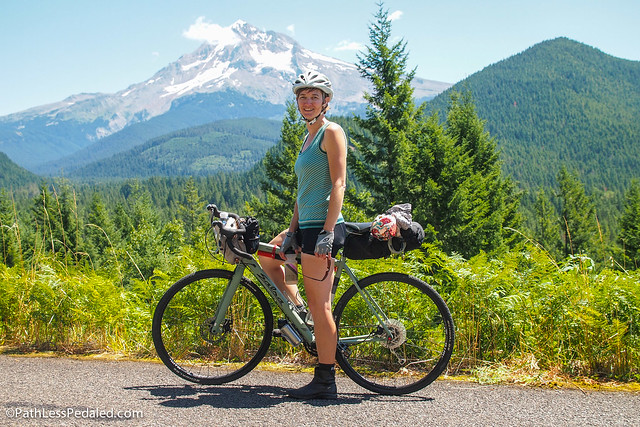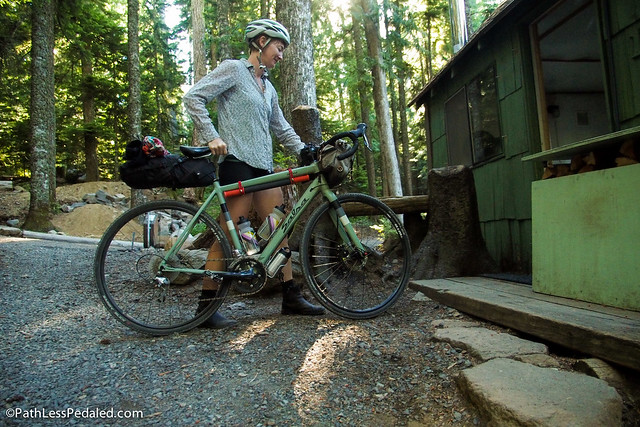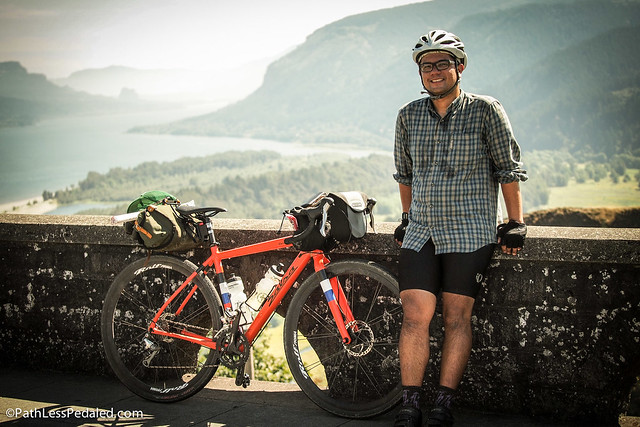Long Term Review: 2016 Salsa Warbird
We’ve been riding the Salsa Warbird for a couple of months and have easily logged over 1000 miles in all sorts of riding conditions. Designed as a gravel race bike and purpose built for events like Dirty Kanza, Trans Iowa and Land Run 100, it seems at first a bit of a strange choice for us since we’re not gravel racers. Over the years, we’ve learned to carry less stuff when we travel by bike and to be perfectly honest, the novelty of carrying heavy loads by bike from place to place has lost some of its appeal. We still love to travel by bike, but are also beginning to be more appreciative of ride quality and handling and the Salsa Warbird has that in spades.
 Climbing up to Vista House on a lightly loaded tour through the Gorge.
Climbing up to Vista House on a lightly loaded tour through the Gorge.
Despite being marketed as a gravel racer, the Warbird is a great all around road bike. Swap out the stock Sammy Slicks with some smoother faster rolling rubber like a pair of Clemente LGGs or something big and luscious like Rivendell Ruffy Tuffys, Vittoria Hypers or Compass Barlow Pass and the Warbird is transformed into a capable endurance disc brake road bike with mixed terrain capabilities. It’s sort of like a modern version of the Rivendell “Country Bike”, good mannered handling but with a go-fast attitude.
 Mt. Hood in the distance on a cabin to cabin tour in Oregon.
Mt. Hood in the distance on a cabin to cabin tour in Oregon.
We’ve taken the Warbirds on long rambling gravel rides as well as long paved rides. We’ve ridden them unloaded and have even packed them down for overnight tours. We still haven’t quite figured out how to carry a full camping kit with the Warbirds, but we did take them recently on a multi-day tour from cabin to cabin over some pretty challenging terrain.
Unloaded, the bikes are a blast to ride. These are our first aluminum frame bikes and I was initially worried about the harshness of the ride. The big bowed seat stays give noticeable compliance in the rear and the carbon fork does a great job at dampening the front. The bike accelerates noticeably quicker than our Vayas and my All City Space Horse, though not as quick as an all out carbon road bike. The handling is responsive but not road bike twitchy and through whatever front-end geometry voodoo, it steers pretty well going down rough terrain as well.
 Negotiating through some baby heads.
Negotiating through some baby heads.
 A fast ride even when the terrain smooths out.
A fast ride even when the terrain smooths out.
Lightly loaded, the Warbird still rides really well. The stock 48-34 cross double paired with the 11-30t rear cassette is great for most terrain, though on a loaded trip where we were climbing 5400ft in 45 miles, I was wishing for another gear to relieve the legs. If we do more loaded touring with them in mountainous terrain, I would probably switch out the drive train to SRAM Apex brifters and run a mountain derailleur with an 11-34 cassette. The stock Tiagra components are functional but not my favorite with the awkward shift cables coming out of the brifters. I would have preferred Apex from the beginning for the neater cable routing and ability to play with long cage derailleurs.
If there are any downsides to the Warbird it is the lack of eyelets for fenders. This is a deal breaker for many in the Pacific Northwest. We’ve sort of accepted that limitation and either suck it up and get wet or run some detachable plastic fenders on the rear. Also, the 42mm tire clearance might not be big enough for some. For most of the riding we have done with them, they were more than adequate.
During the last few months, I did manage to mangle my Warbird. On a trip to Eastern Oregon we rode through some ridiculous peanut butter mud complete with rock chunks. My derailleur committed hair-kari as I was slowly trying to pedal up a hill. Before I knew it, I came to a grinding unceremonious halt. That ride claimed another derailleur that day as well. As good as the mud clearance is, there will be some conditions when you will have to walk.
 Take note. When the mud gets this bad, start walking!
Take note. When the mud gets this bad, start walking!
Perhaps more disconcerting was the carbon fork. I noticed after the ride that the mud and rock chunks had started to abrade the insides of the fork. I sent the fork to Salsa and they determined the abrasion wasn’t structural and gave me the all clear. This isn’t specific to the Warbird, but to any of the new generation of gravel/adventure/all-road bikes with carbon components. If conditions get muddy and rocky, be sure to check for possible abrasion points. After seeing this first hand, it would be awesome if they created a “gravel guard”, some alloy plate embedded in the carbon fork and rear stays designed to specifically take the abuse.
 You don’t have to be a gravel racer to enjoy the Warbird!
You don’t have to be a gravel racer to enjoy the Warbird!
If you’re not a gravel racer and have no plans to ever toe the line at the Dirty Kanza or Trans-Iowa should you even consider the Warbird? We think so. Its a road bike that doesn’t get skittish when the tarmac turns to gravel. In our fleet, it is our go to bike when we only have an hour or two to spare and want to bang out some quick miles with some climbing. It won’t replace the Vaya as our touring bike, but for quick and lightly loaded tours where we aren’t carrying all our camping gear, the Warbird lets us thoroughly enjoy both the journey and the destination.
Tags In
14 Comments
Leave a Reply
This site uses Akismet to reduce spam. Learn how your comment data is processed.
Subscribe
Patreon
Join Team Supple on Patreon
PayPal





I have been reading your reviews and wanted to say thank you for your detailed breakdown of the gear you guys use. You mentioned that you have an All City Space Horse. Will you be doing a review on that bike as well? I have been looking at adventure/light touring bikes but haven’t committed to anything just yet; at least until I get enough research on where to narrow it down.
Hey there Edward,
The Space Horse is a fun bike. It is definitely a light touring bike. Anything more than 50lbs and it will flex like a wet noodle. That said, it makes a great platform for a rando bike, all-rounder or light tourer. The only downside, at least for me, was the stock gearing was a little high for long and steep loaded stuff. Ended up swapping out with a wide-range double configuration. Also, the stock cantis are meh. I’ve grown really fond of disc brakes now and wish they’d come out with a disc version.
Best,
Russ
For the front fork, maybe you could try putting a “Mucky Nutz” fender on. It’s a small flexible plastic bit that extends out to the front about 6 inches, and out the back about the same. It bends and slides through the front fork crown, and attaches to the fork with Velcro straps. I put one on my Surly ECR to keep rocks from kicking up into my face. I had to trim the rear part to clear the downtube.
Beautiful pictures – and it’s great to have all these new highly functional bicycles. Personally I would not buy a bike with “war” in the name. Not what I like to think about when I’m out riding.
You can try a simple derailleur hanger extension to increase the capacity of the largest cog on your cassette. It’s called a Lindarets the RoadLink (lindarets.com). This allowed me to use a Shimano XTR9000 (or now an XT8000) 11-42 cassette with a medium cage Shimano Ultegra rear derailleur. Intended for a 1×10 or 1×11 configuration, I’ve found I am able to use it with my CX (36/46) crankset with a little longer chain and extra ‘B’ screw tension, but very little other adjustments. I’m riding a similar bike, a DiamondBack Haanjo Trail for adventure/gravel riding. I initially wanted to use my 29er wheelset, but it’s not 11speed road compatible. Turns out the XTR cassette fits on a 10speed free hub (due to hub/spoke geometry and the huge cog overhanging the spoke heads), successful bike hax!
Brian,
Thanks for the suggestion. Been curious about the Roadlink.
Russ
You could put on a 42? They recommend only upto 40 with a double.
NIce review as usual!
I’ve been scouring around for a road-centric bike as well, and was initially looking at a Synapse or BMC Granfondo…..then I realized how bad the asphalt was on the trails/paths I ride.
This consideration led me back to the Warbird, as I could run wider rims/tires.
Quick question…..Do you feel more stretched out on the Warbird than on your Vaya?
I have a 56cm Vaya as well, and was wondering about the Warbird sizing, as the ETT is a wee bit longer (5mm), and the headtube 15mm shorter, than an equal sized Vaya (56cm).
I’m sure this is can addressed by a shorter stem, but wanted to get your thoughts just the same.
Thanks!
Hi there Sean,
The Warbird is definitely a racier geometry and is longer/lower than the Vaya. We’ve set ours up so it’s a little more aggressive than the Vaya for sure, but not a completely slammed stem.
For comparisons sake I ride a 54 Vaya and went with a 53 Warbird. Laura rides a 57 Vaya and went with a 56 Warbird and a slightly shorter stem (80mm).
The Warbird makes a fun and comfortable road bike. We did a trip to Lodi where the riding would be all road and I swapped in some 28mm tires and it was great. The next week we did a gravel ride and I put in some 38mm tires.
Super versatile and fun to ride, but definitely more go-fast oriented than the Vaya.
Russ
Hello,
How tall are you and what size Warbird did you buy?
I am 5′ 7″ with about a 31 inch inseam and I am not sure if I should purchase a 53 or 55?
Thanks
Perry,
I’m 5’8″ with a 29 inch inseam and ride the 53 with a slightly shorter stem. It sounds like the 53 might be just the right size for you.
Russ
Hi Russ.
Love your blog Sir. I am also 5’8, but with 31″ inseam (without shoes). I do mostly roadbike ride, with occasional XC with 29er fulsus.
Would you recommend 53cm or 55cm size for the 2016 warbird? Personnally I like the look of 55cm frame better. But coming from road background, the 140mm headtube is rather too tall. Thanks for the input !
do you have any idea what the warbird you tested with the sram and zipp components would cost?
whats the rear rack pictured?